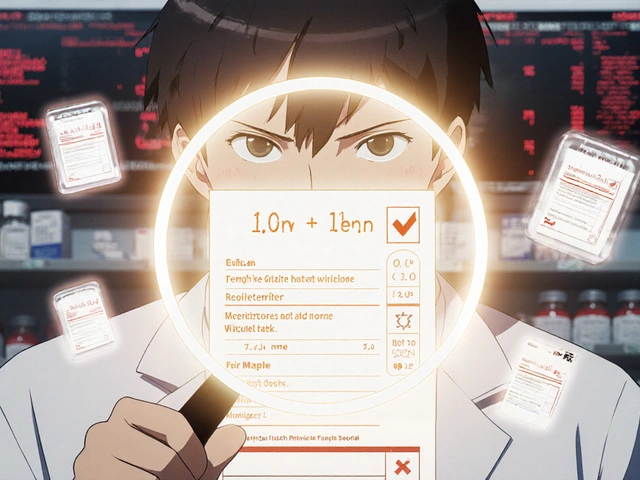Struggling to think clearly when you’re depressed isn’t just frustrating-it can wreck work, studies, and daily life. The promise here is simple: can a modern antidepressant improve memory, attention, and processing speed, not just mood? Short answer: yes, vortioxetine shows small-to-moderate cognitive gains in adults with major depression, and some of those gains seem to go beyond mood relief. But it’s not a smart pill, and it won’t fix dementia. Here’s how to tell if it’s worth trying, what the data actually says, and how to use it well.
- Vortioxetine (also known by brand names like Trintellix/Brintellix) can improve processing speed, attention, and verbal learning in adults with major depressive disorder (MDD).
- Benefits are generally small-to-moderate but clinically useful, and partly independent of mood improvement in several trials.
- Expect early signals by weeks 2-4, with clearer gains by 6-8 weeks; track with simple at-home tests or work/study milestones.
- Common side effects: nausea, headache, constipation; watch for drug interactions (CYP2D6), bleeding risk with NSAIDs, and hyponatraemia in older adults.
- Not a cognitive enhancer for healthy people or a treatment for dementia; use it when depression plus cognitive fog is the problem.
What vortioxetine is and why memory is on the table
vortioxetine is a multimodal antidepressant licensed for major depressive disorder. Unlike classic SSRIs, it both blocks serotonin reuptake and directly modulates several serotonin receptors (5-HT1A agonism; 5-HT3 and 5-HT7 antagonism; partial 5-HT1B agonism). Why should that matter to memory and thinking? Those receptor actions can influence downstream neurotransmitter systems-glutamate, acetylcholine, and norepinephrine-linked to attention, learning, and processing speed. That’s the neurobiology case. The practical case is cleaner: when you treat depression, cognition often improves. The key question is whether vortioxetine moves cognition more than you’d expect from mood lift alone. Multiple trials tried to tease that apart.
What people usually want from a “pro-cognitive” antidepressant isn’t genius-level performance. It’s the basics: fewer word-finding stalls in meetings, quicker email triage, less rereading pages, and better recall of names, tasks, or lecture content. In research, these show up as higher scores on tests like the Digit Symbol Substitution Test (DSST) for processing speed/attention, and the Rey Auditory Verbal Learning Test (RAVLT) for memory. Those are the outcomes you’ll see mentioned below.
If you’re in the UK, you’ll also see vortioxetine in NICE guidance. It’s a treatment option for adults with MDD, typically considered after at least two other antidepressants haven’t delivered enough benefit. That’s a cost-effectiveness lens, not a verdict on efficacy, but it does affect NHS access pathways. Either way, the cognitive angle applies across settings: you consider it when depression and brain fog travel together.
What the evidence actually shows on cognition
Three building blocks matter here: randomized trials against placebo, head-to-head comparisons with other antidepressants, and meta-analyses that pool data to see if the cognitive signal holds up and whether it exceeds mood effects.
- Placebo-controlled RCTs: Several adult MDD trials reported statistically significant improvements on DSST (processing speed/attention) and RAVLT (verbal learning/recall) with vortioxetine 10-20 mg/day versus placebo. Importantly, when researchers adjusted for change in depressive symptoms, a meaningful part of the cognitive benefit remained, hinting at a direct pro-cognitive effect. Key names to know: Mahableshwarkar and colleagues (randomized trials published 2014-2015) and Katona’s work in older adults.
- Active-comparator data: Versus duloxetine or venlafaxine, results vary by study and domain, but vortioxetine often shows comparable mood response with an edge on DSST and certain memory domains. Not all head-to-heads favor vortioxetine, but the pattern for processing speed/attention is fairly consistent.
- Meta-analyses: McIntyre and colleagues (International Journal of Neuropsychopharmacology, 2016) pooled RCTs and reported small-to-moderate improvements in DSST and RAVLT with vortioxetine. Effect sizes tended to sit in the 0.2-0.35 range-not dramatic, but noticeable in day-to-day functioning for many people.
Here’s a condensed snapshot of published findings. Numbers shown are representative ranges from peer-reviewed trials; individual studies will sit above or below these.
| Study (year) | Population | Measure(s) | Effect vs placebo / comparator | When seen | Notes |
|---|---|---|---|---|---|
| Mahableshwarkar et al. (2015, RCT) | Adults with MDD | DSST; RAVLT | DSST +2 to +4 points; RAVLT small gains (SMD ~0.2-0.3) | Weeks 4-8 | Benefits partly independent of mood changes after adjustment |
| Katona et al. (2012, RCT; older adults) | ≥65 with MDD | DSST; attention/working memory batteries | Small-to-moderate improvements vs placebo | By week 8 | Watch hyponatraemia risk in this age group |
| McIntyre et al. (2016, meta-analysis) | Pooled adult MDD RCTs | DSST; RAVLT | SMD ~0.2-0.35 in speed/attention and verbal learning | 4-8+ weeks | Signal persists after controlling for depressive symptom change |
| Active comparator trials (2014-2017) | Adults with MDD | DSST; verbal memory tests | Often favors vortioxetine on DSST; mixed on memory vs SNRIs | 6-8 weeks | Mood efficacy comparable to SSRIs/SNRIs |
What does “SMD ~0.3” mean in human terms? If multitasking at work feels like wading through syrup, a 0.3 effect translates into a noticeable-though not night-and-day-boost in speed and consistency. Many patients say they make fewer errors, reread less, and feel less lost mid-sentence. That’s meaningful.
Two honest caveats: first, not everyone feels it. A minority report no cognitive lift despite mood gains. Second, the measures used in trials are proxies. They’re reliable, but they’re still tests. That’s why tracking your own real-world markers (emails cleared, study pages retained, meeting contributions) matters alongside any questionnaire.
Where evidence is thin or negative: healthy adults without depression (no reason to expect benefit), established dementias like Alzheimer’s or Lewy body disease (no supporting data), and ADHD as a primary diagnosis (not an ADHD medication). If your main problem isn’t depression, this isn’t the right tool.
How to use it well: who benefits, dosing, tracking, and real-world tips
Use this section as a practical guide. The goal is to give yourself a fair trial, measure what matters, and avoid common pitfalls.
Who tends to benefit most:
- Adults with MDD whose top complaints include slowed thinking, poor concentration, memory slips, and mental fatigue-especially if those linger even when mood lifts a bit.
- People who struggled with sexual side effects on SSRIs; vortioxetine generally has a friendlier sexual side-effect profile than many SSRIs/SNRIs.
- Older adults with depression and cognitive slowing, with careful monitoring for hyponatraemia and falls risk.
Who may not benefit much:
- Healthy individuals seeking a “nootropic.”
- People whose main issue is untreated sleep apnoea, heavy alcohol use, sedating meds, untreated ADHD, hypothyroidism, or B12 deficiency. Fix those first, or the drug will underwhelm.
- Suspected dementia. Different pathway, different treatments.
Dosing basics (adults): start 5-10 mg once daily, target 10-20 mg. Many clinicians begin at 10 mg in younger adults, 5 mg in older adults or those prone to nausea. Reassess at 2-4 weeks; if tolerated but unclear benefit, consider 15-20 mg. In the UK, brand and supply may vary, but dosing is the same.
Time course: some people feel mental “lightness” in the first 1-2 weeks; crisp gains in attention and speed usually show by weeks 4-8. Mood and anxiety may move earlier or later. Give it at least 6-8 weeks at a reasonable dose before you call it.
Side effects and how to handle them:
- Nausea (most common): often fades after 1-2 weeks. Try bedtime dosing, small snack, ginger tea. If stubborn at 10 mg, a slower titration helps.
- Headache, dizziness, constipation: usually transient. Keep fluids up; gentle exercise.
- Sexual effects: usually milder than SSRIs but can occur. If persistent, discuss dose timing or adjunct strategies.
- Serotonin syndrome risk: higher if combined with other serotonergic drugs (e.g., triptans, linezolid, MAOIs, St. John’s Wort). Know the signs: agitation, sweating, tremor, confusion.
- Bleeding risk: increases with NSAIDs/aspirin/anticoagulants.
- Hyponatraemia: mainly in older adults, those on diuretics, or with low baseline sodium-watch for confusion, unsteadiness.
Drug interactions to check:
- CYP2D6 inhibitors (e.g., fluoxetine, paroxetine, bupropion) can raise vortioxetine levels; dose reduction may be needed.
- Strong enzyme inducers (e.g., carbamazepine, rifampicin) can reduce levels; some people need higher doses or a different antidepressant.
- MAOIs: contraindicated. Respect washout periods.
Pregnancy and breastfeeding: human data remain limited; decisions hinge on severity of illness and prior response. Discuss risks and options in detail before starting or stopping.
How to track cognitive change (no lab coat needed):
- Pick two work/study markers and one home marker that matter to you (e.g., emails cleared per hour, pages read with full recall, number of “lost my train of thought” moments in meetings).
- Do a simple baseline: time yourself on a paper DSST (many printable versions exist) and note your RAVLT-style recall by reading a 15-word list aloud and writing down what you remember after 1 minute and after 20 minutes.
- Start the medication and repeat the same tests at weeks 2, 4, and 8. Keep the conditions similar (time of day, caffeine, location).
- Chart the trend. If you see a steadier email pace, fewer rereads, and a DSST bump of 2-4 points by week 6-8, that usually means it’s doing something useful.
Rules of thumb to decide next steps:
- By week 4: no side effects and slight lift in speed/attention? Hold the dose or nudge up.
- By week 6-8: no cognitive gain and minimal mood change? Consider switching, adding bupropion/modafinil in selected cases, or checking for sleep, thyroid, B12, iron, or medications that slow you down (sedating antihistamines, benzodiazepines).
- If mood improves but cognition drags: check for anxiety, poor sleep, pain, and medication load; small dose increase can help, but don’t chase perfection if side effects mount.
A quick decision tree:
- If depression + cognitive fog → consider vortioxetine trial.
- If no depression (or minimal) → do not use it for cognition; investigate other causes.
- If partial response → optimize dose or augment judiciously; keep tracking.
- If no response by 8 weeks at a fair dose → switch strategy.
Quick answers, risks, and alternatives when memory is the goal
Mini‑FAQ
- Does vortioxetine improve memory independent of mood? Several RCTs and a 2016 meta-analysis reported cognitive benefits that persisted after adjusting for depression scores. The strongest, most reproducible signal is on processing speed/attention (DSST), with smaller but real gains on verbal learning (RAVLT).
- How big are the gains? Think small-to-moderate. On lab tests: DSST often rises a couple of points over placebo; on daily life: smoother task switching, less rereading, fewer “lost” moments.
- How long before I notice anything? Sometimes within 2 weeks, but give it 6-8 weeks for a fair look at cognition.
- Is it better than SSRIs or SNRIs for thinking? Often, yes for processing speed; mixed for memory. Mood efficacy is broadly comparable.
- Can I take it with bupropion or modafinil for extra focus? Sometimes, with medical supervision and attention to interactions, anxiety, and sleep. This is an off-label augmentation decision, not a DIY move.
- Will it help in dementia or mild cognitive impairment? No good evidence. Use the right tools for the right problem.
- What about withdrawal? Its long half-life means fewer discontinuation symptoms than many SSRIs, but tapering is still sensible.
Risks and safety checklist (read before starting):
- Any history of serotonin syndrome? Review all serotonergic meds and supplements.
- On blood thinners or frequent NSAIDs/aspirin? Discuss bleeding risk and warning signs.
- Older adult, diuretics, low sodium before? Check baseline sodium and recheck after starting/titrating.
- Liver issues or many interacting meds? Review for CYP2D6 interactions.
- Planning pregnancy or currently breastfeeding? Have a risk-benefit talk before changes.
Credible alternatives if cognition is your main complaint within depression:
- Bupropion: activating, can sharpen attention; less sexual side effects. Not as robust as vortioxetine on validated cognitive test batteries, but very helpful for some.
- SNRIs (e.g., duloxetine, venlafaxine): improve mood, sometimes help cognitive symptoms; head-to-head cognitive results are mixed.
- Adjuncts: modafinil/armodafinil (fatigue, vigilance) in selected cases; psychostimulants short-term in resistant cases with tight monitoring. Not first-line.
- Non-drug: fix sleep (including sleep apnoea), treat pain, exercise 3-5 days/week (aerobic plus light resistance), review sedating meds, and address alcohol use. These are often the biggest unlocks.
What the research actually cited:
- Mahableshwarkar AR et al., randomized, double-blind trials (2014-2015) showing DSST and RAVLT improvements with vortioxetine in adult MDD.
- Katona C et al., randomized trial in older adults with MDD (2012) reporting benefits on speed/attention measures.
- McIntyre RS et al., meta-analysis in the International Journal of Neuropsychopharmacology (2016) showing small-to-moderate cognitive gains, partly independent of mood change.
Next steps / Troubleshooting
- If you’re starting: set two real-world markers and one simple test (DSST or a word list), then retest at weeks 2, 4, and 8. Note side effects daily for the first two weeks.
- If you’re at week 4 with minimal change: check sleep, pain, and meds. Consider dose increase if tolerated.
- If you’re at week 8 with no cognitive lift: ask about switching or augmenting. Bring your tracking notes-they make decisions faster and cleaner.
- If you’re older or on multiple meds: request a sodium check two weeks after each dose change and after any new interacting medicine.
- If you’re doing better but still messy on busy days: pair the medication with structure-time-blocking, email batching, and 25-minute focus sprints with 5-minute breaks. Medication plus habits beats medication alone.
One last expectation reset: the average effect size in trials is modest, but the personal payoff can be big if cognition is what keeps tripping you up at work or school. Set a clear goal, give it a fair trial, and measure what matters to you. That’s how you find out if this is your tool.







Megan C.
August 29, 2025 AT 12:13We have to ask ourselves if it’s ethical to pop a prescription pill just because it promises a tiny boost in mental sharpness. The line between treating genuine depressive fog and chasing a novelty nootropic is razor‑thin. I feel uneasy when clinicians market these drugs as quick fixes for ‘brain fog’ without emphasizing the underlying psychiatric diagnosis. People deserve honest, evidence‑based guidance, not hype dressed up as a miracle.
Greg McKinney
September 8, 2025 AT 04:53Looks like another overhyped antidepressant to me.
Dawna Rand
September 18, 2025 AT 01:00Hey folks! 🌟 If you’re battling that foggy‑brain feeling alongside depression, giving vortioxetine a fair trial might be worth it. 🎯 Start low, track simple stuff like how many emails you clear in an hour, and watch for that subtle lift. 👍 Side‑effects like nausea usually fade after a couple of weeks, and the sexual side‑effect profile is often gentler than classic SSRIs. Keep a diary, stay patient, and celebrate even the small wins! 🌈
Effie Chen
September 27, 2025 AT 21:06Just a quick note – the data show a modest bump in processing speed, not a Hollywood‑level genius upgrade. 🧠 If you notice you’re rereading emails less, that’s a real win. Remember to rule out sleep apnea or low B12 first; meds won’t fix those. 😊 Keep the tracking simple and you’ll know if it’s helping.
rohit kulkarni
October 7, 2025 AT 17:13The question of whether a molecule can be deemed a true cognitive enhancer is nothing short of a modern philosophical conundrum.
When we speak of vortioxetine we are confronting a compound that, by design, attempts to modulate several serotonergic receptors while simultaneously inhibiting reuptake.
Such multimodal activity invites a cascade of downstream effects upon glutamate, acetylcholine, and norepinephrine, each of which is implicated, to varying degrees, in attentional and mnemonic processes.
From a mechanistic standpoint, the drug’s 5‑HT1A agonism may promote cortical plasticity, whereas its antagonism at 5‑HT3 and 5‑HT7 receptors could dampen inhibitory circuits that otherwise blunt information flow.
Empirically, randomized controlled trials have reported statistically significant upticks in Digit Symbol Substitution Test scores, typically ranging from two to four points above placebo.
Equally noteworthy are the modest gains observed on the Rey Auditory Verbal Learning Test, where effect sizes hover around 0.2 to 0.35.
Crucially, these improvements persist even after statistical adjustment for depressive symptom change, suggesting an effect that is not merely epiphenomenal.
One must, however, temper enthusiasm with the recognition that effect sizes in the cognitive domain are modest, and that the ecological translation of a two‑point DSST rise can vary dramatically among individuals.
Moreover, the heterogeneity of study populations-spanning younger adults to octogenarians-introduces a layer of complexity that precludes a simple, one‑size‑fits‑all prescription.
The safety profile, while generally favorable, is not devoid of concerns; nausea, headache, and, in a subset of elderly patients, hyponatraemia demand vigilant monitoring.
Drug–drug interactions, particularly with CYP2D6 inhibitors, further complicate the therapeutic calculus, reminding us that the serotonergic system is a delicate tapestry rather than an isolated thread.
From an ethical perspective, prescribing vortioxetine primarily for its pro‑cognitive promise in a non‑depressed individual would constitute a misuse of medical resources.
Conversely, for a patient whose depressive illness is intertwined with debilitating brain fog, a judicious trial of the medication may indeed be justified.
The clinician’s role, therefore, is to balance empirical evidence with individual patient narratives, monitoring both mood and objective cognitive markers over a period of six to eight weeks.
Only through such a disciplined, data‑informed approach can we discern whether the theoretical advantages of multimodal serotonergic modulation translate into genuine functional improvement.
In sum, vortioxetine offers a modest but measurable cognitive benefit that appears at least partially independent of mood elevation, yet it remains far from a panacea.
RONEY AHAMED
October 17, 2025 AT 13:20Honestly, I’ve tried a few meds and this one’s side‑effects are pretty chill after a week. The brain‑fog lift I felt was subtle but real – I could finish a report without rereading a paragraph. If you’re handling a busy schedule, give it a solid 6‑8 weeks before deciding.
emma but call me ulfi
October 27, 2025 AT 08:26Just wanted to say, I’ve seen folks benefit without any drama. Keep it low‑key and see how it goes.
George Gritzalas
November 6, 2025 AT 04:33Oh great, another “miracle pill” that promises to turn you into a human calculator. 🙄 Let’s be real: the effect sizes are laughably small, barely enough to make you notice a difference on a lab test you’ll never see in daily life. And don’t forget the nausea that hits you like a surprise party you didn’t ask for. If you wanted a boost, you could just drink a coffee and actually get something. Also, the marketing jargon about “multimodal action” sounds impressive but it’s just a fancy way of saying ‘we hit a lot of receptors, hope something works.’ In short, don’t expect to out‑perform your coworkers after a month on this. Keep expectations grounded.
Alyssa Matarum
November 16, 2025 AT 00:40Vortioxetine can help, but it’s not a silver bullet. Track your own progress and talk to your doc.
Lydia Conier
November 25, 2025 AT 20:46Hey team! 🌼 If you’re thinking about giving this a go, start by noting two simple daily tasks – like how many emails you send without re‑reading and how many pages you remember from a meeting. I tried it last year and, after a month, I was finally able to finish a presentation without the “uh‑uh‑uh” moments. Just remember to keep an eye on any stomach upset – it usually fades, but if it sticks around, let your doctor know. Also, don’t forget to check your sodium if you’re over 60; they don’t tell you that enough! Lastly, stay patient – the real-world gains often show up after about six weeks.
ruth purizaca
December 5, 2025 AT 16:53The literature is thorough, yet the practical impact feels marginal. It’s a nuanced addition to the toolbox, not a game‑changer.
Shelley Beneteau
December 15, 2025 AT 13:00Building on the earlier philosophical note, I’d add that the heterogeneity of individual neurochemistry means we should expect variable responses, especially in older cohorts where baseline cognitive reserve differs markedly. It’s also worth mentioning that the methodological rigor of many RCTs, while generally high, sometimes underrepresents real‑world polypharmacy scenarios that could attenuate the observed benefits.
Sonya Postnikova
December 25, 2025 AT 09:06Great points all around! 😊 If you decide to try it, remember to celebrate the small wins – even a slight reduction in “I need to reread that email” moments is progress. Keep a simple log and share your experience; it helps everyone see the bigger picture. 🌟